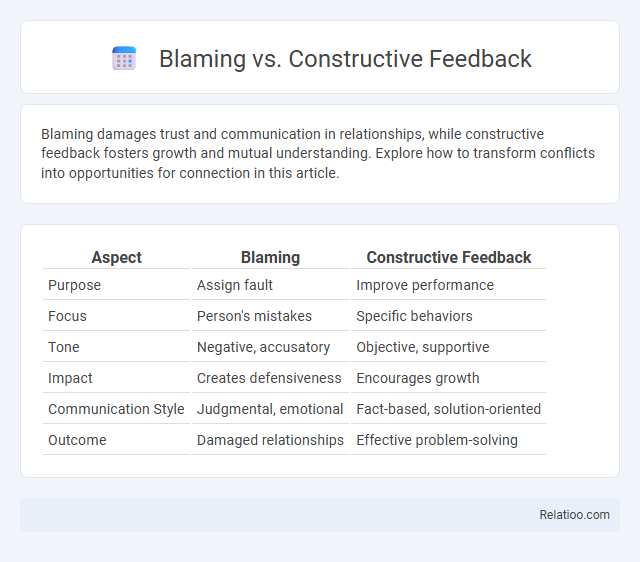Blaming damages trust and communication in relationships, while constructive feedback fosters growth and mutual understanding. Explore how to transform conflicts into opportunities for connection in this article.
Table of Comparison
| Aspect | Blaming | Constructive Feedback |
|---|---|---|
| Purpose | Assign fault | Improve performance |
| Focus | Person's mistakes | Specific behaviors |
| Tone | Negative, accusatory | Objective, supportive |
| Impact | Creates defensiveness | Encourages growth |
| Communication Style | Judgmental, emotional | Fact-based, solution-oriented |
| Outcome | Damaged relationships | Effective problem-solving |
Understanding Blame and Constructive Feedback
Understanding blame involves recognizing its tendency to assign fault without offering solutions, which can create defensiveness and hinder growth. Constructive feedback provides specific, actionable guidance aimed at improvement while maintaining respect and support for Your development. Differentiating between blame and constructive feedback is essential for fostering a positive environment that encourages learning and accountability.
Key Differences Between Blaming and Feedback
Blaming centers on assigning fault and often leads to defensiveness and reduced motivation, whereas constructive feedback focuses on specific behaviors and actionable improvements to promote growth. While blaming targets the individual, constructive feedback separates the person from the problem, fostering a positive environment for learning. Key differences include the communication style, intent, and impact on relationships and performance within teams.
The Impact of Blaming on Team Morale
Blaming within a team environment significantly undermines morale by creating fear and reducing trust among members. Constructive feedback, in contrast, fosters growth and collaboration by focusing on solutions rather than fault. You can improve your team's dynamics by prioritizing constructive feedback to maintain motivation and drive positive outcomes.
Benefits of Offering Constructive Feedback
Offering constructive feedback enhances team performance by identifying specific areas for improvement without assigning fault, fostering a culture of growth and trust. Your support in providing actionable suggestions encourages skill development and problem-solving, leading to higher productivity and employee engagement. Constructive feedback reduces blame-related conflicts and promotes open communication, driving continuous improvement within the organization.
Common Triggers for Blame in the Workplace
Common triggers for blame in the workplace include unclear expectations, miscommunication, and high-pressure environments that increase stress and reduce team cohesion. You can shift focus from blaming to constructive feedback by fostering open dialogue, promoting accountability, and setting clear, achievable goals. Addressing these triggers helps enhance problem-solving and improve overall organizational performance.
Elements of Effective Constructive Feedback
Effective constructive feedback emphasizes specific behavior, clear communication, and actionable suggestions to foster improvement and growth. It focuses on observable facts rather than assumptions, avoiding blame to maintain a positive and respectful tone that encourages collaboration and learning. Elements such as timely delivery, empathy, and a balance between strengths and areas for development enhance the feedback's impact and promote productive outcomes.
How to Transition from Blaming to Supporting
Transitioning from blaming to supporting involves recognizing the impact of negative judgment on relationships and productivity, then consciously adopting a mindset focused on problem-solving and empathy. Effective techniques include using "I" statements to express feelings without assigning fault, encouraging open dialogue to understand underlying issues, and emphasizing collaborative goal-setting to foster accountability and growth. Employees and leaders who shift towards supportive feedback create a positive workplace culture that enhances motivation, trust, and continuous improvement.
Language Choices: Blame vs Constructive Communication
Blaming language often includes accusatory words like "you failed" or "this is your fault," which trigger defensiveness and hinder problem-solving. Constructive communication uses neutral, specific language such as "the project missed the deadline due to unclear requirements," promoting understanding and collaborative resolution. Emphasizing solutions over fault encourages a positive dialogue that drives improvement and accountability.
Cultivating a Feedback-Driven Organizational Culture
Cultivating a feedback-driven organizational culture requires shifting from blaming to constructive feedback that fosters growth and collaboration. Constructive feedback emphasizes specific behaviors and actionable suggestions, enhancing employee development and trust, while blaming creates defensiveness and hinders problem-solving. Organizations that prioritize transparent communication, psychological safety, and continuous learning see higher engagement and performance outcomes.
Overcoming Challenges in Giving and Receiving Feedback
Overcoming challenges in giving and receiving feedback requires distinguishing between blaming and constructive feedback, with the latter fostering growth by focusing on behavior and solutions rather than personal faults. Constructive feedback emphasizes specific, actionable insights that encourage improvement, whereas blaming often triggers defensiveness and hinders open communication. Developing skills in empathetic listening and clear communication mitigates resistance and promotes a collaborative environment for continuous development.

Infographic: Blaming vs Constructive Feedback
 relatioo.com
relatioo.com